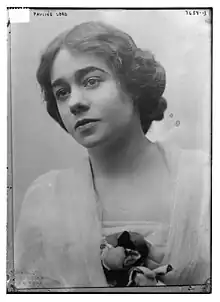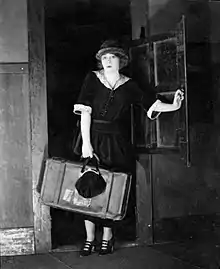Pauline Lord | |
|---|---|
 Pauline Lord in 1915 | |
| Born | August 13, 1890 Hanford, California, US |
| Died | October 11, 1950 (aged 60) Alamogordo, New Mexico, US |
| Occupation(s) | Stage, film actress |
| Years active | 1903–1946 |
| Spouse | Owen B. Winters (1929–1931) |
Pauline Lord (August 13, 1890 – October 11, 1950) was an American stage and film actress.
Early years
Lord was born in Hanford, California, to Edward Lord and Sara Foster. When the family moved to San Francisco she attended Holy Rosary Academy, where she discovered her vocation from participating in a school play. As a youngster, she used her weekly allowance to attend Saturday productions at the Alcazar Theatre in San Francisco and eventually gained small parts in some of those plays.[1] She graduated from the Jennie Morrow Long College of Voice and Action.[2]
Career
At age 13, she debuted professionally with the Belasco Stock Company in the play Are You a Mason? where her first role was that of a maid. The comedian Nat Goodwin saw her act and invited her to look him up if she ever got to New York City. Three years later, after the San Francisco Fire, at the age of 16, she made the trip, and true to his words, Goodwin put her to work with several tour engagements. Fired from her first tour, she returned to New York and acted in some plays there before returning to California.[1]

Her first Broadway role was in January 1912 as Ruth Lenox in The Talker[3] followed by more tours and vaudeville parts. Her next hit was in August 1917 as Sadie in The Deluge, directed by Arthur Hopkins.[1] It was not until November 2, 1921, that she again scored another hit where she starred in the title role of Eugene O’Neill's Anna Christie at the Vaudeville Theatre on Broadway. This turned out to be her greatest success; the play was taken to London, and at the Strand Theatre on April 10, 1923, she received a half-hour ovation. In 1924, she starred as Amy in Sidney Howard's They Knew What They Wanted and later in 1928 as Nina Leeds in O’Neill's Strange Interlude. Mary Pickford listed her as one of her favorite stars.[4]
Lord returned to the stage in 1932 playing Abby in Sidney Howard's The Late Christopher Bean. She made her film debut in 1934 as Mrs. Wiggs of the Cabbage Patch, followed by A Feather in Her Hat,[3] released the following year. She found she was not interested in cinema and returned to the stage. In January 1936, she played Zenobia in Owen and Donald Davis’ dramatization of Edith Wharton's Ethan Frome. Her last appearance on stage was in 1946 as Amanda in a touring company's production of Tennessee Williams' The Glass Menagerie.[3]
Personal life and death
Lord married advertising executive Owen B. Winters on April 27, 1929. They divorced on October 26, 1931.[5]
She died on October 11,1950 of chronic asthma and heart disease at Champion Memorial Hospital in Alamogordo, New Mexico.[6]
References
- 1 2 3 "Sidney Howard Wrote His New Play Especially for Pauline Lord, Then Finished It in Rehearsals". The Brooklyn Daily Eagle. New York, Brooklyn. October 30, 1932. p. 60. Retrieved December 7, 2019 – via Newspapers.com.
- ↑ "(untitled brief)". Sunset Magazine. XIII (2): 184. June 1904. Retrieved December 7, 2019.
- 1 2 3 Liebman, Roy (2017). Broadway Actors in Films, 1894-2015. McFarland. p. 161. ISBN 978-1-4766-2615-4. Retrieved December 7, 2019.
- ↑ Howe, Herbert (January 1924). "Mary Pickford's Favorite Stars and Films". Photoplay. New York: Photoplay Publishing Company. Retrieved September 4, 2015.
- ↑ "Pauline Lord Called Cruel as Husband Sues in Reno," New York Daily News, p. 3, Saturday, October 24, 1931.https://www.newspapers.com/image/414100676/?terms=%22Owen%20B%20Winters%22
- ↑ "Actress Pauline Lord, 60, Succumbs at Almogordo," Albuquerque Journal, p. 19, Thursday, October 12, 1950. https://www.newspapers.com/image/158205495/?terms=%22Pauline%20Lord%22&match=2
- Behringer, Clara M. "Lord, Pauline" Notable American Women. Vol. 2, 4th ed., The Belknap Press of Harvard University Press, 1975 ISBN 978-0-674-62734-5.
External links
- Pauline Lord at the Internet Broadway Database
- Pauline Lord at IMDb
- Pauline Lord portrait at NYP Library